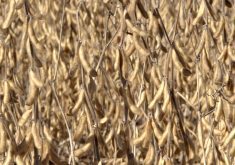Chicago | Reuters — An arctic blast hitting the U.S. Midwest this week will put a third of the dormant soft red winter (SRW) wheat crop at risk of damage, agricultural meteorologists said Monday.
“It looks like extensive sub-zero temperatures on Wednesday night in the soft wheat belt will leave one-third of the belt at risk for damage,” Joel Widenor, senior forecaster with Commodity Weather Group, told Reuters Ags Forum online chatroom.
“The cold temperatures will cover even more of the belt, but snow will fall tonight and provide some partial protection to limit the extent of damage a little bit,” Widenor added.
Read Also

U.S. grains: Soybeans hit six-week low as Brazilian harvest looms; corn, wheat sag
Chicago | Reuters – Chicago soybean futures fell to six-week lows on Friday as worries about slowing export demand for…
Overnight lows on Wednesday are expected to dip to -20 to -26 C across eastern Nebraska and southwestern Iowa, eastward to Illinois, Indiana, Ohio and southern Michigan. Forecasters also were calling for one to five inches of snow to fall in the upper Midwest overnight Monday.
Snow cover protects dormant wheat from winterkill, when temperatures dip below 0 F (-18 C) for four hours or more. The damage can prevent the crop from reaching its full yield potential next summer.
“Outright wheat losses might be five per cent or so,” said Don Keeney, senior meteorologist with MDA Weather Services, referring to the potential winterkill.
The wheat grown in the Midwest is used in snack foods and crackers and makes up about a quarter of the U.S. wheat crop. Most of the wheat produced in the U.S., the world’s top wheat exporter, is hard red winter wheat grown in the Plains.
A week ago, an arctic blast hit the Plains HRW wheat country, when temperatures dipped well below 0 F, including south central Nebraska where morning lows fell to -8 F (-22 C).
“There were a few spots in south central Nebraska and north central Kansas that did get to winterkill thresholds. But it was a small area, a couple percent of the belt,” Keeney said. “The area that will be affected by the upcoming cold is a bigger area.”
— Christine Stebbins is the Reuters Ags Forum community editor and a Reuters correspondent covering grains markets from Chicago.














